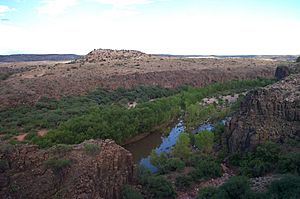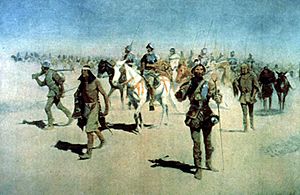Antonio de Espejo facts for kids
Quick facts for kids
Antonio de Espejo
|
|
|---|---|
| Born | 1540 |
| Died | 1585 (aged 45) |
| Nationality | Spanish |
| Occupation | Explorer |
Antonio de Espejo (1540–1585) was a Spanish explorer. He led an important trip into what is now New Mexico and Arizona between 1582 and 1583. His journey made many people interested in starting a Spanish settlement among the Pueblo people who lived along the Rio Grande river.
Contents
Life of Antonio de Espejo
Antonio de Espejo was born around 1540 in Cordova, Spain. He came to Mexico in 1571 with a leader named Pedro Moya de Contreras. This leader was sent by the Spanish king to set up a special court called the Inquisition.
Espejo and his brother became ranchers in the northern part of Mexico. In 1581, Espejo and his brother faced legal issues. His brother was put in prison, and Espejo had to move to Santa Barbara, Chihuahua. This was the northernmost Spanish outpost in Mexico at the time. He was there when another Spanish group, the Chamuscado-Rodriguez expedition, returned from New Mexico.
Journey to New Mexico
Espejo was a wealthy man. He put together and paid for his own expedition. The main reason for his trip was to find out what happened to two priests. These priests had stayed behind with the Pueblo people after the Chamuscado-Rodriguez expedition left.
On November 10, 1582, Espejo and his group set off from San Bartolome. His group included fourteen soldiers, one priest, about 30 Native American helpers, and 115 horses.
Espejo followed the same path as the earlier Chamuscado and Rodriguez group. They traveled down the Conchos River to where it met the Rio Grande. Then, they went up the Rio Grande to reach the Pueblo villages.
Along the Conchos River, Espejo met the Conchos Indians. These people ate fish, mesquite plants, and mescal and lechuguilla (types of agave). Further down the river, he found Conchos people who grew corn, squash, and melons. After leaving the Conchos, Espejo met the Passaguates, who lived in a similar way. Next, he found the Jobosos, who were shy and ran away from the Spanish. All these tribes had been affected by Spanish slave raids before.
Near where the Conchos and Rio Grande rivers met, Espejo entered the land of the Patarabueyes. These people attacked his horses, killing three. Espejo managed to make peace with them. He said the Patarabueyes and other Indians near La Junta were also called "Jumanos". This was the first time this name was used for these people. They were also known as Otomoacos and Abriaches. Espejo saw five Jumano settlements with about 10,000 people. They lived in low, flat-roofed houses. They grew corn, squash, and beans, and also hunted and fished. They gave Espejo well-prepared deer and bison skins.
After the Jumanos, he passed through the lands of the Caguates or Suma. They spoke the same language as the Jumanos. He also met the Tanpachoas or Mansos. Espejo found that the Rio Grande Valley was full of people all the way up to where El Paso, Texas is today. North of El Paso, the group traveled for 15 days without seeing anyone.
Meeting the Pueblos
In February 1583, Espejo reached the land of the Piros. These were the southernmost Pueblo villagers. From there, the Spanish continued up the Rio Grande. Espejo described the Pueblo villages as "clean and tidy." Their houses were tall, with many levels, and made of adobe bricks. Espejo noted that they made "very fine tortillas." The Pueblos also gave the Spanish turkeys, beans, corn, and pumpkins. The people "did not seem to be warlike." The Pueblos in the south only had clubs for weapons, along with a few "poor Turkish bows and poorer arrows." Further north, the Native Americans were better armed and more aggressive.
Some Pueblo towns were very large. Espejo said that Zia had 1,000 houses and 4,000 men and boys. For farming, the Pueblos used irrigation. They had "canals and dams, built as if by Spaniards." The only Spanish item Espejo noticed the Pueblos wanted was iron. They would try to steal any iron they could find.
Espejo learned that the two priests had been killed by people in the Pueblo village of Puala. This village was near what is now Bernalillo. As the Spanish came close to Puala, the villagers ran away to the nearby mountains. The Spanish continued exploring, both east and west of the Rio Grande. They seemed to face no resistance from the Native Americans. Near Acoma, they noted that a group called Querechos lived in the nearby mountains. These Querechos traded with the townspeople. These Querechos were actually Navajo. The Apache people of the Great Plains were also called Querechos during this time.

Espejo also visited the Zuni and Hopi people. He heard stories about silver mines further west. With four men and Hopi guides, he went to find these mines. He reached the Verde River in Arizona, probably near Montezuma Castle National Monument. He found mines near what is now Jerome, Arizona. However, he was not impressed by how much silver they might hold. From the local Native Americans, probably Yavapai, he heard about a large river to the west. This was likely the Colorado. Among the Hopi and Zuni, Espejo met several Spanish-speaking Mexican Indians. These individuals had been left behind by, or had escaped from, the Coronado expedition over 40 years earlier.
The priest, some soldiers, and the Native American helpers decided to return to Mexico. This happened even though Espejo asked them to stay. It's possible the priest did not like how Espejo dealt with the Pueblos. Espejo and eight soldiers stayed behind to look for silver and other valuable metals.
The small group had a fight with the people of Acoma Pueblo. This happened when two women who were with the Spanish managed to escape. The Spanish tried to get them back, and there was a conflict. A Spanish soldier was hurt. The Acomans and the Spanish exchanged shots from their harquebus guns, stones, and arrows. This showed the Spanish that the Pueblo people had limits to their hospitality. The Spanish then went back to the Rio Grande Valley. In one village, they had a difficult encounter with the local people who refused them food. This led to a very serious conflict.
The Spanish quickly left the Rio Grande. They explored eastward, traveling through the Galisteo Basin near where Santa Fe would later be built. They reached the large pueblo at Pecos, which they called Ciquique.
Return Journey
Instead of going back through the now unfriendly Rio Grande Valley, Espejo decided to return to Mexico using the Pecos River. He called it "Rio de Las Vacas" (River of the Cows). This was because they saw many bison during the first six days they followed the river downstream. After going down the river about 300 miles from Ciquique, the soldiers met Jumano Indians near Pecos, Texas. These Jumanos guided them across the land, up Toyah Creek, and then across country to La Junta. From there, they followed the Conchos River upstream to San Bartolome, where they had started. They arrived on September 20, 1583. The priest and his companions had also returned safely. Espejo was the first European to travel most of the length of the Pecos River.
Espejo died in 1585 in Havana, Cuba. He was on his way to Spain to try and get permission from the king to start a Spanish colony in New Mexico. A record of his expeditions was later written by the Spanish historian and explorer Baltasar Obregón.
See also
 In Spanish: Antonio de Espejo para niños
In Spanish: Antonio de Espejo para niños



